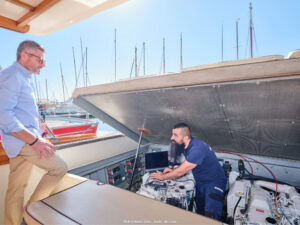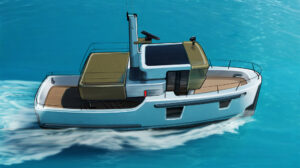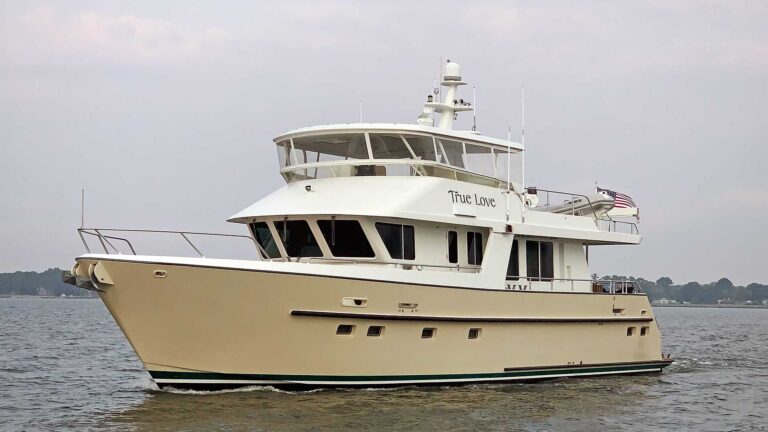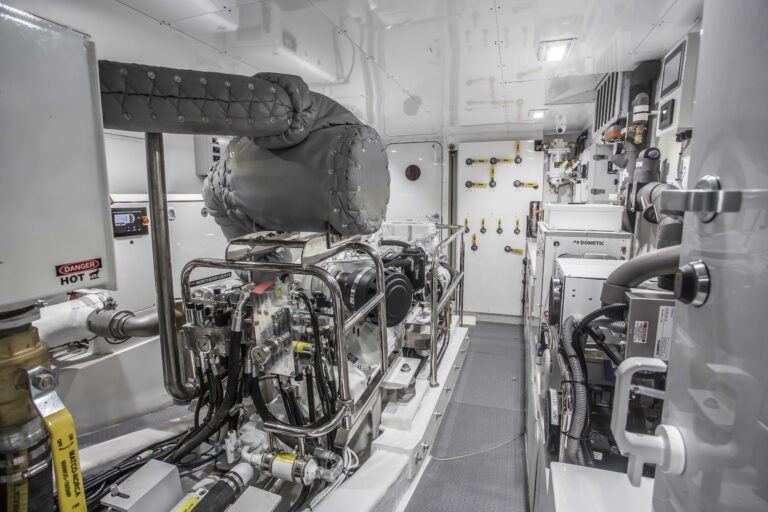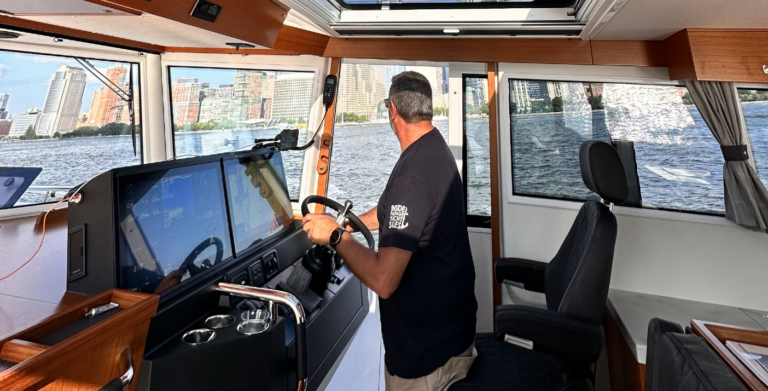Almost every cruising boat built since the mid-1990s contains core material in the hull and/or deck and cabin. Cored boats are lighter, stiffer, quieter and better insulated than their solid ancestors. Builders have a variety of materials from which to choose, including end-grain balsa wood, closed-cell foams, and honeycombs.
In a previous Troubleshooter column, I wrote about how to detect core moisture intrusion, and how to prevent the intrusion from happening. Moisture in the core can be a major obstacle to the sale of a boat, and it usually and substantially reduces the value. In some cases, a wet core can weaken the structure.
If you own a boat with elevated core moisture, or if you are considering buying one with that problem, what remedies are available?
Material Differences
While moisture in any core material matters, it matters more in some materials than in others. Of the three basic choices (balsa wood, closed-cell foams, and honeycomb) only one—balsa wood—will decompose because of the ongoing presence of moisture. Balsa has its virtues, offering excellent strength at roughly half the cost of most foams. Unfortunately, left exposed to water for a period of years, balsa will morph from stiff, end-grain wood to something resembling wet cardboard.
Closed-cell foams and synthetic honeycombs also can retain moisture, but unlike balsa, they will not decompose. Elevated moisture levels will affect the sale of most boats, but the situations are markedly different.
Elevated moisture in any core raises two questions. First, does the presence of moisture weaken the boat structurally? Second, does the moisture affect the boat’s value? Conflating the two questions leads to overreaction and poor decisions.

Structural Considerations
Let’s start with the structural question. Away from the public eye, this question has been hotly debated in trade journals, a fact that tells us the answers are far from clear.
Cored structures have been carefully engineered to account for the variety of stresses they must withstand on a moving vessel. A given boat design must account for the properties of the core material, the thickness of the core, the thickness of the fiberglass skins, and the adhesion of these components to one another. Changing any of those properties affects strength.

All cored structures will be weakened if the fiberglass skins lose their bond to the core material. Given a combination of high moisture content and a freeze-thaw cycle, the risk of separating the skin from the core increases. Almost all liquids contract when they freeze, but water is a notable exception (otherwise, ice cubes would sink). If moisture collects in any air pockets between the core and the skin, and if that water freezes and expands, then the size of the air pocket can expand, gradually debonding the skin from the core.
Only structures with excessively high moisture levels risk this condition. This kind of failure can be identified by sounding with a plastic mallet. Assuming that the core remains sound and the moisture can be removed, this problem can be remedied by injecting epoxy resin through small holes, and then compressing the skin against the core.
The more challenging question concerns the condition of the core material after ongoing exposure to moisture. All the debate within the industry centers on balsa core. Other than skin detachment, as described above, closed-cell foams and honeycombs have not been shown to deteriorate with prolonged exposure to water. Leave balsa core wet enough for long enough, and it will turn into mush.
This potential outcome begs two questions: How wet, and how long?
For wood rot to take place, spores must flourish. These spores need a food source, oxygen and water. The balsa wood provides an abundant food source. Oxygen can be found in the tiny air spaces between the core blocks, and in the water. And water can find its way in through leaking fittings fastened into the core. Studies performed for the lumber industry show that spores need a minimum 20 percent moisture content to live, and 28 percent to thrive.
How long can be hard to say, but we are talking about years, not months. Depending on the conditions, it might take 10 years of exposure to decompose the balsa.

Value Considerations
Almost all cored boats 10 years old will have elevated moisture somewhere. The impact on value will depend on the core material choice, the moisture level present, the size and number of affected areas, and the duration of the exposure.
Given the number of variables, assigning a dollar value can be next to impossible. A confined area with known deteriorated core (balsa) presents the clearest cost scenario, since the repair requirement is known and can be estimated. Localized elevated readings, say around a windlass foot switch, can usually be easily corrected, with the costs quantified.
But what about a balsa structure with elevated readings, but not readings high enough to support rot? And what about honeycomb or foam with elevated moisture, but no risk of core damage? In these situations, trying to come up with a dollar value is a fool’s errand.
A buyer must account for this issue with the knowledge that when the time comes for him to sell the boat, he will face the same problem. Perhaps a price adjustment can be worked out, but you also run the risk that a potential buyer gets spooked and walks away.

Repair Options
Before cutting into a balsa-core structure with high meter readings, some core samples should be taken. If those samples reveal core that suffers from rot, then it must be removed. Decomposed balsa presents the most severe core degradation scenario. Rotten balsa indicates a substantial weakening of the structure. The inner or outer fiberglass skin will have to be cut away, and the affected core removed and replaced. The skin can then be laminated in place and bonded to the new core. A fair amount of cosmetic work will be needed to hide repairs.
The more common situation involves any one of the core materials with high moisture readings but no degradation. Even cores with high moisture meter readings can look and feel dry. In most cases, the moisture can be more appropriately imagined as humidity rather than collected water.
Regardless of the type of core, you need to find the point of entry for moisture. The moisture meter and/or an infrared camera can help point the way.
Let’s assume that you found some leaking deck hardware and some penetrations through the core, with the core material left exposed. Correcting these deficiencies will stop moisture ingress, but what about the high moisture levels already in the core? Unfortunately, these levels will stubbornly remain high.
Reducing the moisture readings to acceptable levels requires a drying process. Dry air must be circulated through the core, and then extracted. We have had some success using vacuum pumps and air dryers to move air through the core, but one company has taken that process to the next level.
Michigan-based Dryboat offers a portable service for drying cores. The Dryboat method combines warmed, extremely dry air with controlled pressure. Last winter, we had a boat in the yard with balsa core and high moisture readings throughout much of the hull sides. Core samples showed the balsa to be sound and visibly healthy. Dryboat set up its equipment and left it running for a couple of months. Periodic checks with the meter showed steady progress, and by spring, the hull had reached acceptable levels. We addressed the sources of moisture penetration, and the boat left for a summer cruise.
By identifying the problem early, taking steps to correct the issue, and finding and stopping the source of moisture, this boat owner preserved the value of his boat and minimized the cost. Left untreated, this boat would have become impossible to sell and nearly worthless.
We recommend having someone check the moisture level of your hull and deck at least once every three years. Balsa-cored boats require a higher level of vigilance, but all cored boats must be monitored.
Properly monitored and maintained, cored structures can provide decades of service life and enhanced boat performance.
Steve Zimmerman is the president of Zimmerman Marine, which operates five boatyards in Maryland, Virginia, North Carolina and South Carolina. Zimmerman has been building and repairing boats for more than four decades.



